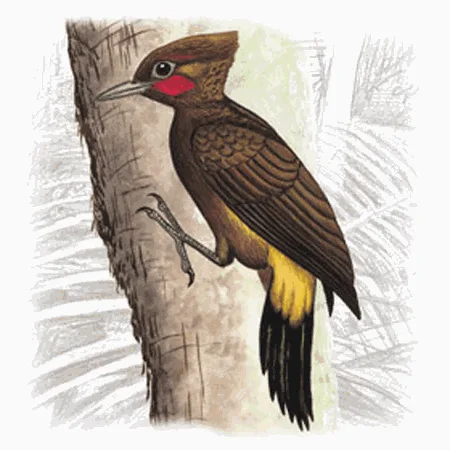
Chestnut Woodpecker
[order] PICIFORMES | [family] Picidae | [latin] Celeus elegans | [UK] Chestnut Woodpecker | [FR] Pic mordore | [DE] Fahlkopf-Specht | [ES] Carpintero Elegante | [NL] Vaalkuifspecht
Subspecies
| Genus | Species | subspecies | Breeding Range | Breeding Range 2 | Non Breeding Range |
| Celeus | elegans | SA | n, Amazonia | ||
| Celeus | elegans | citreopygius | e Ecuador and e Peru | ||
| Celeus | elegans | deltanus | ne Venezuela | ||
| Celeus | elegans | elegans | French Guiana and ne Brazil (n of the Amazon) | ||
| Celeus | elegans | hellmayri | e Venezuela, Guyana and Suriname | ||
| Celeus | elegans | jumanus | e Colombia and s Venezuela to n Bolivia | ||
| Celeus | elegans | leotaudi | Trinidad |
Physical charateristics
The Chestnut Woodpecker has an overall chestnut brown coloration with a yellow rump and flanks and a yellowish crest. The wings and tail are black and the bill yellowish. The male has a red malar stripe, but otherwise the sexes are similar.
Listen to the sound of Chestnut Woodpecker
[audio:http://www.aviflevoland.nl/sounddb/C/Chestnut Woodpecker.mp3]
Copyright remark: Most sounds derived from xeno-canto
| wingspan min.: | 0 | cm | wingspan max.: | 0 | cm |
| size min.: | 26 | cm | size max.: | 32 | cm |
| incubation min.: | 0 | days | incubation max.: | 0 | days |
| fledging min.: | 0 | days | fledging max.: | 0 | days |
| broods: | 0 | eggs min.: | 2 | ||
| eggs max.: | 4 |
Range
South America : North, Amazonia
Habitat
The habitat of this large woodpecker is a variety of dense and light forest and cacao plantantions. Lowland species.
Reproduction
The excavated nest hole is in dead tree or stub, with the chamber floor 30 cm deep below the entrance. Clutch size 3 eggs, no further details.
Feeding habits
The Chestnut Woodpecker forages inconspicuous from understorey to mid level canopy, diet consists of ants, termites, larvae and sometimes fruit. mostly in pairs or small groups up to 5 individuals, found gleaning, hammering termite nests and rather acrobatic eating fruit.
Conservation
This species has an extremely large range, and hence does not approach the thresholds for Vulnerable under the range size criterion (Extent of Occurrence <20,000 km2 combined with a declining or fluctuating range size, habitat extent/quality, or population size and a small number of locations or severe fragmentation). The population trend appears to be stable, and hence the species does not approach the thresholds for Vulnerable under the population trend criterion (>30% decline over ten years or three generations). The population size has not been quantified, but it is not believed to approach the thresholds for Vulnerable under the population size criterion (<10,000 mature individuals with a continuing decline estimated to be >10% in ten years or three generations, or with a specified population structure). For these reasons the species is evaluated as Least Concern.

Migration
Sedentary throughout range.
Distribution map

